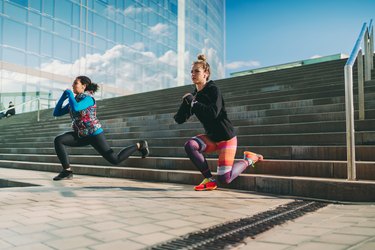

Bulgarian split squats are an excellent example of a love and hate relationship: You love the results but dread the process with equal measure.
And if you're making a few common Bulgarian split squat mistakes, this move will feel way harder than it needs to be. The next time this exercise makes an appearance in your workout routine, avoid this four errors to get the most out of this challenging move.
Video of the Day
Video of the Day
1. Rocking Side to Side
One reason Bulgarian split squats can feel so challenging is the stability they demand from the muscles and joints they are working. After all, balancing on one leg while bending down and straightening back up is no easy feat.
That's why swaying side to side is a common mistake with Bulgarian split squats, according to New York-based physical therapist Cameron Yuen, DPT, CSCS. It's also a pretty clear sign that you may be lacking the mobility or strength needed for the weight you're lifting.
"The body should move almost entirely in the forward/backward and up/down directions," Yuen says. If you don't have sufficient stabilization or lack lower-body mobility, your knees and hips may move side to side. "This isn't the intention of the exercise and can lead to pain or injury because you load the joints in ways they don't usually move," he says.
Fix It
Slow down each rep and make sure that your foot, ankle, knee, hip and spine are facing in the same direction throughout the exercise, Yuen says. Drop your weight if this is challenging and use a mirror to check your form as needed.
2. Not Choosing a Goal
If you're going to put the effort into doing Bulgarian split squats, you want to get as much out of the move as possible. That includes choosing which muscle you want to focus on: your quads or your hamstrings and glutes.
By changing your front foot placement, you can target specific lower-body muscles, according to Yuen. "[But] if you don't pay attention to your technique, you won't really progress towards your goals," he says.
Fix It
To target your hamstrings and glutes, take a longer stance away from the bench. Press into the heel with each rep and lean forward slightly. For a quad focus, keep your stance shorter and back tall.
3. Leaning on Your Back Leg
Another reason Bulgarian split squats are so tricky? You're working one leg at a time. Although it's not a true unilateral exercise (like single-leg deadlifts) because both legs are on the ground, your back leg should only supply a little extra balance.
If you put too much weight on your back leg, your front leg won't get the intended benefit of the exercise, Yuen says. Your grounded leg should initiate all the motion of the movement with most of your weight loaded there.
Relying too heavily on your back leg can also be painful for the knee. In the Bulgarian split squat, your back knee isn't in a safe position to support a lot of weight.
Fix It
"Instead of leaning on the back leg, set up in your stance and then intentionally bring your weight forward slightly," Yuen says. This will take some of the pressure off your back foot. If you're working with dumbbells, drop your weight or keep a chair close by for some extra help balancing.
4. Sticking to the Same Variation
Along with foot position, you can change up your resistance or load to get more from the Bulgarian split squat. Incorporating different variations of the Bulgarian split squat in your workout routine is how you can get the most benefit from the exercise, according to Yuen.
Most often, this exercise is done with a dumbbell in each hand, he says. This variation allows for more balance and heavier loads, but it doesn't challenge your lower-body and core stability as much as other alternatives. If this is the only version you're doing, you may be missing out on some strength-building advantages.
Fix It
"Instead of always holding two dumbbells, try holding just one on a single side. This shifts the stability demands to different muscles, leading to increased muscle recruitment," Yuen says.
"If you focus too much on stability with one dumbbell, you might be missing out on single-leg strength increases. Try switching single dumbbell use for a barbell on your back. This will reduce some of the stability demands allowing you to generate more force on the stance leg."
You can also try this exercise holding kettlebells in a front-rack position. This position will test your core strength.